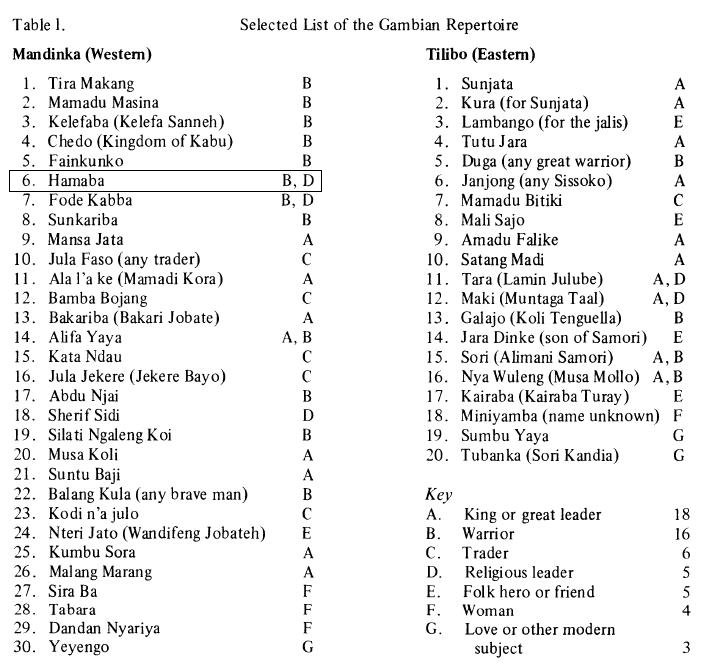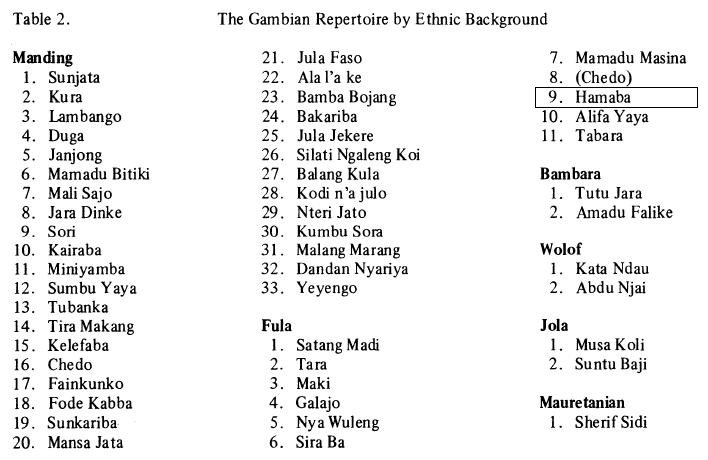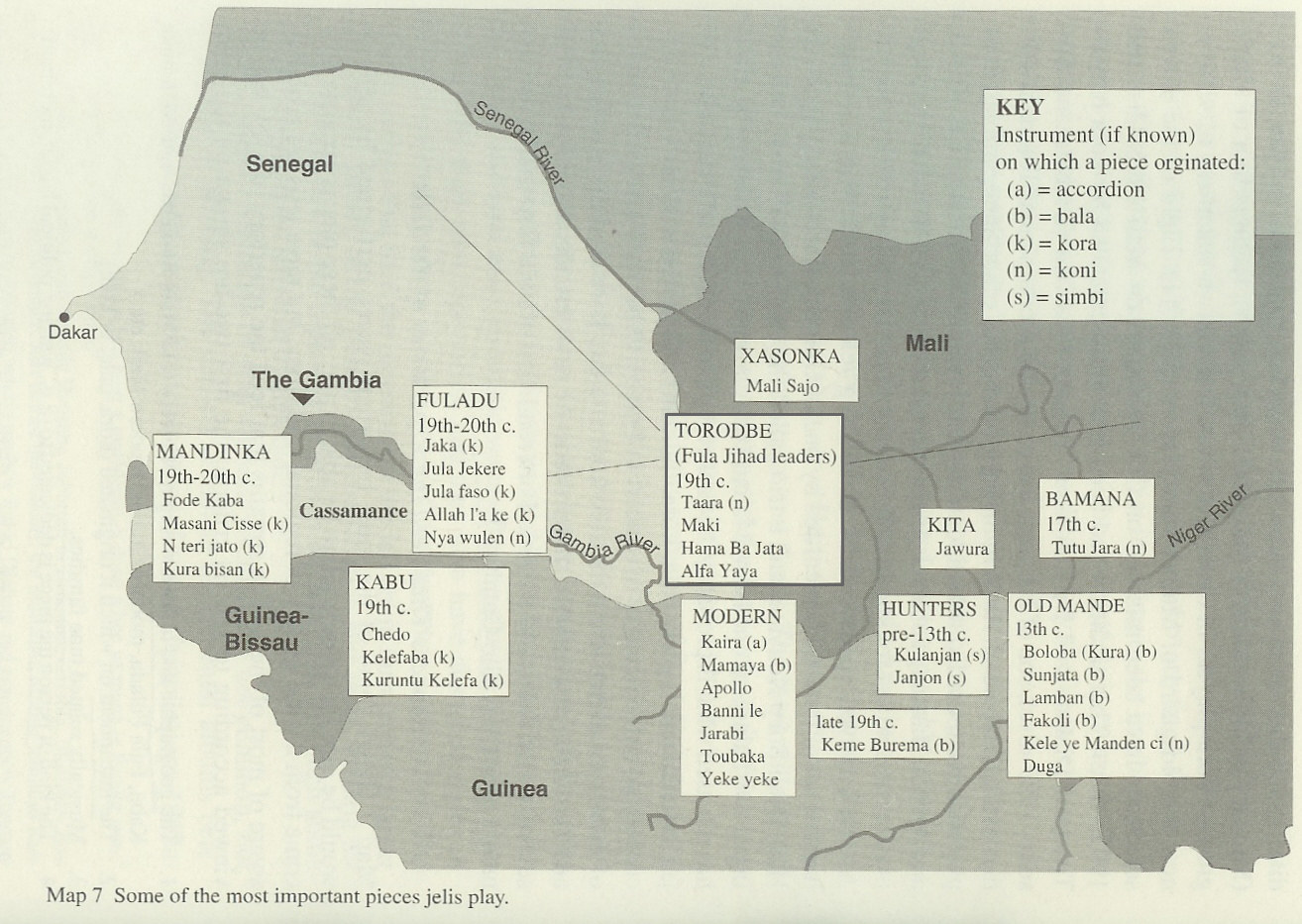hama ba jata
Knight, Roderic. 1982a. "Manding/Fula Relations as Reflected in the Manding Song Repertoire." African Music 6 (2): 37–47.
(Hamaba)
p. 39
Table One . . . includes the best known, most often heard, or otherwise significant songs in the [Gambian] repertoire. In each column the top few songs are the oldest, and the bottom few are the youngest. The majority in each case fall somewhere in between (often in the nineteenth century), but no chronological ordering beyond this is intended, since it is often not possible to date a song exactly. Most of the songs bear the name of their owner as the title. Where they do not, his name is shown in parentheses next to the title. The letter code at the right represents the person's "claim to fame" or calling in life, as shown in the bottom of the list.

p. 40
Table Two shows the same fifty songs again, grouped this time by the ethnic background of the people commemorated.

p. 41
Hama Ba, or Ma Ba, the leader of the jihad in the area of the Sine and Saloum Rivers in Senegal and along the North Bank of the Gambia River, according to the official version of his ancestry, was a descendant of the Denianke dynasty of Futa Toro (Quinn 1967). The dynasty was founded in the sixteenth century by a Fula named Koli Tenguella (Labouret 1959), also known as Guelajo or Galajo. Hama Ba and Galajo are both included in the Manding repertoire, and Galajo is an important figure in Fula songs as well. In Hama Ba's song, the jali sings of his religious zeal: "Kafirolu kele, sum bali, sali balolu kele, Hama Ba Jata." ("Fight the heathens, fight those who refuse to fast and those who refuse to pray, Hama Ba the Lion!")
p. 43
Hama Ba was greatly inspired by El Hadj Omar, the Tukulor leader of the much more extensive jihad carried out against the infidels of the Fula and Bambara kingdoms of the interior.
p. 44
Jaka . . . is a version of Hama Ba in a different tuning.
Konte, Bai. 1982. Konte Family Mandinka Music: Kora Music and Songs from The Gambia. Virgin, VX 1006.
(Hamma Ba)
"This is Bai Konte speaking to you. This song was composed in honour of Hamma Ba, who was a warrior-king. Later on it was called jaka, and it has also been played in honour of Cherno Bande (son of the last king of The Gambia), but it really is for Hamma Ba." Hamma Ba, whose real name was Maba Jakou, came from the north bank of the Gambia river and lived during the first half of the 19th century. He made a name for himself as a zealous Muslim crusader against the infidel. Bai sings, "Holy king, go to war—Hamma Ba."
Jessup, Lynne. 1983. The Mandinka Balafon: An Introduction with Notation for Teaching. La Mesa, Calif.: Xylo.
(Hamaba)
pp. 146–59 (Appendix 2: Balafon Repertoire)
| Title | Hamaba |
| Translation: | Name |
| Dedication: | Same, or Maba |
| Notes: | a Fula man, similar to Jakaa |
| Calling in Life: | Warrior, Religious leader |
| Original Instrument: | Kora |
| Region of Origin: | Manding (Western Coastal Region) |
| Date of Origin: | M (19th & 20th c. up to WWII) |
| Sources: | 1, 3, 4 (Jessup & Sanyang, R. Knight 1973, R. Knight 1972) |
Jobarteh, Amadu Bansang. 1993. Tabara. Music of the World, CDT 129.
(Hama Ba Jata; excerpt)
Hama Ba was a 19th century leader who aided in the unification of Gambia. This instrumental excerpt is played in a classic Gambian style. The right thumb sets a steady rhythm while the left plays a counter rhythm on pitch 2, slightly dampening each note after it is struck. All the while, the two forefingers play descending melodies and chords in the higher registers.
Charry, Eric. 2000. Mande Music: Traditional and Modern Music of the Maninka and Mandinka of Western Africa. Chicago; London: University of Chicago Press.
(Hama Ba Jata)
p. 148

p. 150
The parent-child relationship of some pieces is common knowledge and is readily talked about as such among many musicians: Saxo (Sacko) Dugu comes from Duga; Jula Jekere from Janjon; and Jaka from Hama Ba Jata.
p. 182
Another example is provided by the pieces Hama Ba Jata and Jaka, which, according to Amadu Bansang Jobarteh and Sidiki Diabate, are played the same way but are distinguished primarily by the tuning in which they are played. Hama Ba Jata is played in Hardino tuning and Jaka is played in Tomora mesengo tuning. This is the only case I know of two pieces being distinguished in this way.